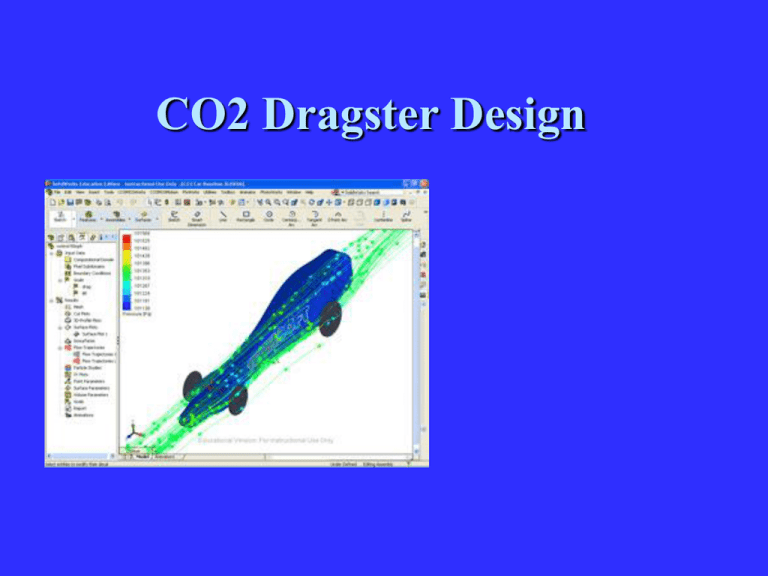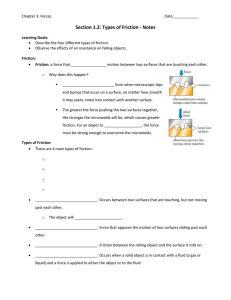CO2 Dragster Design
advertisement

CO2 Dragster Design Research and Development Objectives Research in CO2 auto design involves the study of a few sciences related to the motion of your dragster. • Aerodynamics- the study of how solid objects displace fluid air and other gases; • Physics- the study of matter in motion; • Tribology- the study of friction; Research and Development Objectives Development of CO2 auto design requires• Understanding the problem or purpose- trying to achieve the fastest speed and/or best appearance; • Knowing your limitations- being aware of safety regulations, materials allowed, specifications, tolerances and functionality; • Making intelligent decisions- taking what you learn and using it to your best advantage; • Testing your solution- comparing results with your classmates to see what works better; Terms to Know- Aerodynamics Fluid Mass Aerodynamics Drag Lift Rear Suction Down Force Frontal Area Research- Aerodynamics Air– Is a type of fluid such as water that can be directed or displaced; – Has mass and is measured in terms of pressure; – Applies direct and frictional forces to objects in motion; Research- Aerodynamics You should be aware of four aerodynamic principles– – – – Drag Lift/Down Force Drag Coefficient Frontal Area Research- Aerodynamics Drag is a combination of two forces that will work against the acceleration of your CO2 car. – Frontal Pressure occurs when tiny molecules of air hit the front of your car and is forced away to make room for other molecules to hit it. – Rear Suction occurs when an empty pocket of air is created in the back of your car resulting in a vacuum cleaner effect that tries to pull your car backward. Air Flow Rear Suction More Science on Suction Since we know that air has mass with weight measured in pressure, we take notice that liquid is pushed up a straw when the balanced air pressure is removed. When fluid air is removed from a surface around your car, air pressure causes the empty space to be filled in by the weight of the atmosphere. Research- Aerodynamics Lift is similar to rear suction in that a thin empty pocket occurs as air passes over a flat surface causing the car to lift. Down Force is due to high pressure in curved surfaces that causes the car to be pushed down. (Up next, notice how the windshield takes the shape of a spoiler.) Air Flow Lift Down Force Air Friction and Lift When a ball rotates in motion, it causes the air around it to flow with the rotation, often changing the direction with lift and down force. The dimples in a golf ball are also used for reducing air friction with the surface. Research- Aerodynamics Drag Coefficient is a way of expressing how slippery a car is. Here is a tip to increase your speed and lower your drag coefficient(the more ways you can eliminate drag, turbulence, rear suction, lift and down force, the faster your car will go) Research- Aerodynamics Frontal Area is the total of all surfaces in the front of your vehicle which cause drag. Area = Length x Width Review With one hand, which can be thrown further, a football . . . or a soccer ball? Review Tips- Aerodynamics Avoid flat upright surfaces in the front of your car to reduce turbulence. Avoid flat upright surfaces in the back of your car to reduce rear suction. Shield as much air at the bottom of your car to maintain traction. Keep the surface area exposed to oncoming air to a minimum. Research- Physics (Preview) Which ball can I hit farther, a base ball or a softball? how about a golf ball? Terms to Know- Physics Force Acceleration Research- Physics Force = Mass x Acceleration Heavier objects require more effort to move at the same speed; It is easier to push a CO2 car out of the ditch than to push an actual car out of the ditch. Research Physics Heavy Mountain Bike •Durable •For Rough Terrain •Requires more Energy Light Racing Bike •Fast •For Long Distance •Requires less Energy Research- Physics How does the angle of your CO2 cartridge affect the efficiency of your car? Review Tips- Physics Avoid unnecessary extensions and ornaments that add weight to your car. The lighter you design your car, the more power will be used out of your CO2 cartridge. Make sure that your drill holes are straight and accurate to reduce extra forces acting on your car. Research- Tribology Tribology is the study of friction between solid surfaces. Friction is a force that resists movement. Friction is found between moving parts and surfaces. Without friction, objects would never come to rest. Where will you find friction forces acting on your car? Research- Tribology How many wheels should you have and why? Research- Triboloby Does the paint job affect your car: Why or why not? Research Physics Heavy Mountain Bike •Wider Ground Contact •More Surface Friction Light Racing Bike •Narrower Ground Contact •Less Surface Friction Review Tips- Tribology Painting your car will reduce aerodynamic friction. Axel design is important to reducing friction. Lubrication of the axels can reduce friction. Less ground contact wheels have with the ground, the less friction will be present. Review Tips- Aerodynamics Avoid flat upright surfaces in the front of your car to reduce turbulence. Avoid flat upright surfaces in the back of your car to reduce rear suction. Shield as much air at the bottom of your car to maintain traction. Keep the surface area exposed to oncoming air to a minimum. Review Tips- Physics Avoid unnecessary extensions and ornaments that add weight to your car. The lighter you design your car, the more power will be used out of your CO2 cartridge. Make sure that your drill holes are straight and accurate to reduce extra forces acting on your car. Review Tips Painting your car will reduce aerodynamic friction. Axle design is important to reducing friction. Less ground contact wheels have with the ground, the less friction will be present. Wisconsin Applicable Teaching Standards By the end of 8th grade, students will be able to: A.8.1 Show that technology has allowed us to further the efforts of science and, in turn, science has enabled us to develop better technology A.8.2 Explain the need for and application of knowledge and skills from other disciplines when engaging in technological activities A.8.3 Identify and contrast the connections and differences between technology and other disciplines A.8.4 Determine that technological knowledge is valuable but not always available to everyone on an equal basis A.8.7 Discover that human will or desire can lead to the design of new technology in order to seize an opportunity or solve a problem




